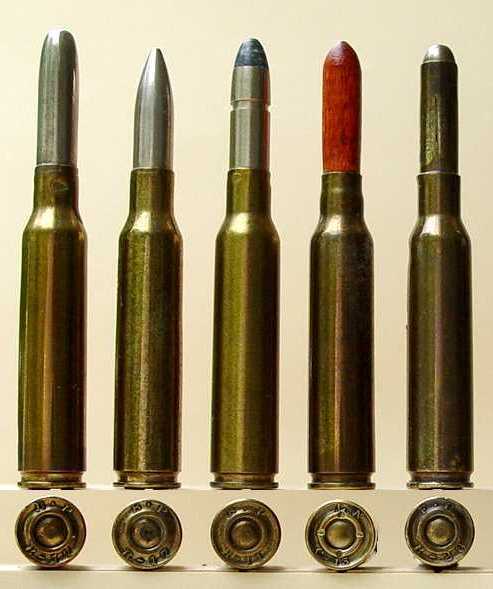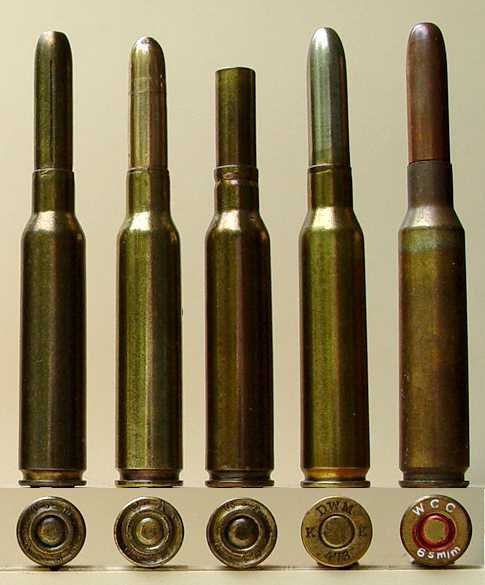|
THE CARTRIDGE COLLECTOR'S EXCHANGE |
| Contents
Cartridge
Lists
Prior Picture Pages:
Links to Other Sites
Cartridge Collectors Organizations:
Auctions:
Books:
Other Collector's Sites:
|
Home of the Old Ammo Guy's Virtual
Cartridge Trading Table Featuring a wide range of antique, obsolete, and modern ammunition for collectors Picture Page August 2007 An assortment of 6.5 x 52 Italian cartridges.......
. ..
.. .
. . . . . . . . .
1. Model 1891/95 standard ball load used in the M91 Mannlicher-Carcano bolt action rifle, which was of a modified Mauser design using a Mannlicher style magazine. Production began in 1891, and continued to World War 2. 2. This spitzer style bullet indicates the cartridge is either an armor-piercing or an armor-piercing incendiary load, neither of which was color coded. They were identifiable only from the box labels. 3. This early style frangible bullet with its wide groove and soft point bullet was intended for use for military or military-sponsored 'shooting club' marksmanship training. Because of the way it is constructed, these cartridges were safer for short range target shooting than standard ball cartridges. 4. The red wood bullet and the two-stage case neck identify this as a Model 1910 blank. the bullet is hollow, and is made of poplar. As with the military blanks used by many countries, the wood bullet was intended to allow the blank to function properly in a rifle or machine gun, and to disintegrate shortly after leaving the muzzle. 5. The grooved bullet jacket indicates that this is a multi-ball or 'canister' cartridge, intended for guard or riot control use. The hollow bullet jacket usually contains 6 lead slugs, with the round nose of the first slug protruding through the open nose of the jacket. Once the bullet leaves the muzzle of the barrel, the jacket splits open allowing the slugs to disperse.
. . . . . . . . . . .. . . . . .
6. This is a later variation of the multi-ball load (# 5), again indicated by the grooves in the bullet jacket, but lacking the exposed lead nose. The bullet jacket is open at the tip, allowing the top of the first lead slug to be observed.
7. This odd looking bullet, with its slightly necked profile and a silver 'seam' joining the nose with the body of the jacket, is the Magistri Model 1937 frangible bullet. Like #3 above, it was intended for shooting club marksmanship training. Two variations are known, one with a cupro-nickel bullet jacket with a 1939 dated headstamp, and the other with a copper jacket and a 1953 dated headstamp, as shown above and in this picture of a full clip. The two piece construction of the bullet and the necked profile is more apparent on the cartridges in the clip.
8. This cartridge is a Model 1939 Gallery cartridge intended for marksmanship training. A brass tube is secured in the case mouth with a heavy neck crimp, which ensures that it remains in place when the cartridge is fired. Missing from this one is the 'bullet', a round nosed lead projectile with a reduced heel that fits down into mouth of the tube. 9. All of the preceding cartridges were manufactured at Italian government facilities for use by the military, but this DWM headstamped cartridge is an early example that was made for sale to the civilian market. The 473 in the headstamp is the case code used by DWM to designate the 6.5 x 52 Carcano. The two 'K's indicate the cartridge was manufactured at the company's Karlsruher facility in Germany sometime prior to 1925. 10. This Western Cartridge Company 6.5 Carcano cartridge has an origin that is not too clear. The headstamp is unusual; the 'WCC' is the headstamp used on Western's military contract ammunition, usually in combination with a two digit date, and the '6.5 m/m' gives the headstamp a commercial look. Some believe it was produced on contract for the CIA, intended for some clandestine purpose by that oft-maligned organization. Others believe it was made on contract for the Italian government, but never delivered for some reason. Either way, the cartridges eventually made their way into the civilian market in the early 1960s. Why it was made has certainly been overshadowed by the fact that several of these cartridges were used by Lee Harvey Oswald in the assassination of President John F. Kennedy in 1963.
A box of WW2 .45-70 line throwing cartridges...... This is a box .45-70 blanks made by the Western Cartridge Company in 1943 for the U.S. Navy to use in passing a line from one ship to another, usually for the purpose of carrying out a transfer of supplies and/or personnel. A light line was attached to the end of a bolt (or rod) which slid down the barrel of a line throwing gun. The gun was aimed to carry the line across the target ship, this line being used to pull across heavier lines which were then used to set up a rig for making the transfer. Early guns used by the Navy for this included modified Springfield Model 1873 trapdoor and Winchester Model 1886 rifles; by the time this box was made, guns made by Harrington & Richardson that were based on their single barrel shotguns were commonly used. It is interesting that this is a two piece box, which generally went out of production for commercial ammunition in the mid-1930, but were still being used for contract .45-70 and .30-40 ammunition much later.
. . . . . .
There appear to have been at least two variations of the .45-70 line
throwing blank. The first was the Mark I which was produced by Western and
Remington in large numbers throughout WW2. The are loaded with 50 grains of
black powder with a single fiber wad seated against the powder, about a
third of the way down in the case.
The other variation that I'm aware of is the M36, which was produced during the 1950s and perhaps later. I don't know if the 'M' stands for Mark or Model. It is loaded with smokeless powder and has three fiber wads, the top of the last one being about halfway down in the case. In addition, the case mouth has a much more pronounced crimp; I am told this was to keep the end of the bolt from entering the cartridge case, as it did on the Mark I blank. .
. . . . . . A closer look at some R. B. Sisk .224 bullets...... I recently picked up these two boxes of .224 bullets made by R. B. Sisk of Iowa Park, Texas in the 1940s. Sisk made custom bullets in a number of calibers for reloaders and wildcatters. The box on the right, labeled 'Wartime Bullets', was made during World War 2; the one on the left was most likely made immediately after the war.
. . . . . When I received it, the wartime box was still sealed, but it didn't take
long for my curiosity to get the best of me, and I opened it to see what
might distinguish a 'wartime' bullet from a 'peacetime' bullet. What I found
was quite interesting. To start with, the packing used to keep the bullets from rattling
around and causing damage to their soft lead points was a
Apparently, Sisk's wartime bullets resulted from his inability to
purchase the copper he needed for the bullet jackets, copper being one one
of the strategic metals that was in short supply during the war. Sisk found another
source, using .22 rimfire cases that he turned into very serviceable
bullets using some type of press, which formed the copper case into its
bullet shape around a lead core. Examples of his bullets are shown in this
picture. The bullet on the left (photographed showing both a base and
profile view) is an example of Sisk's 'peacetime'
bullet, probably
. . . . |



